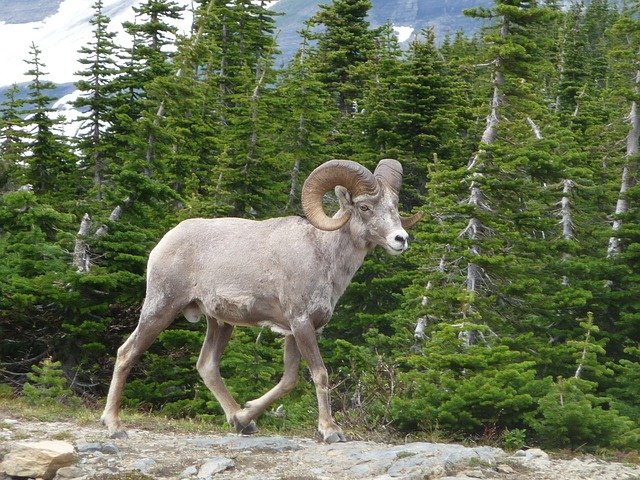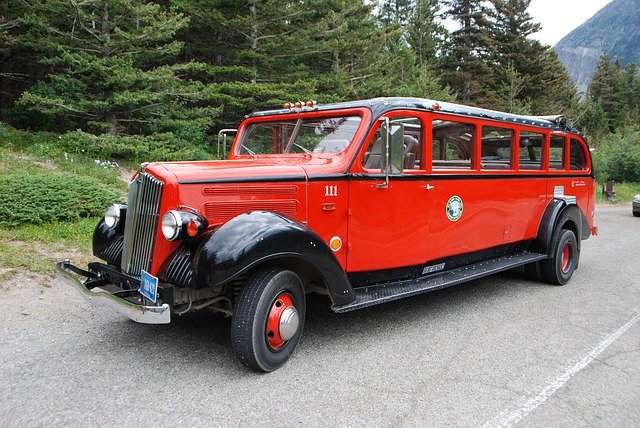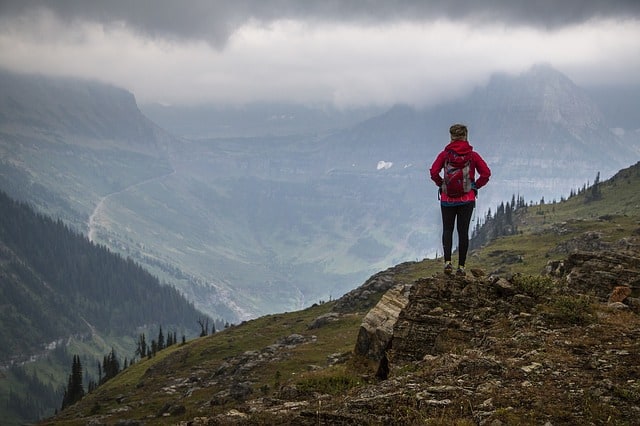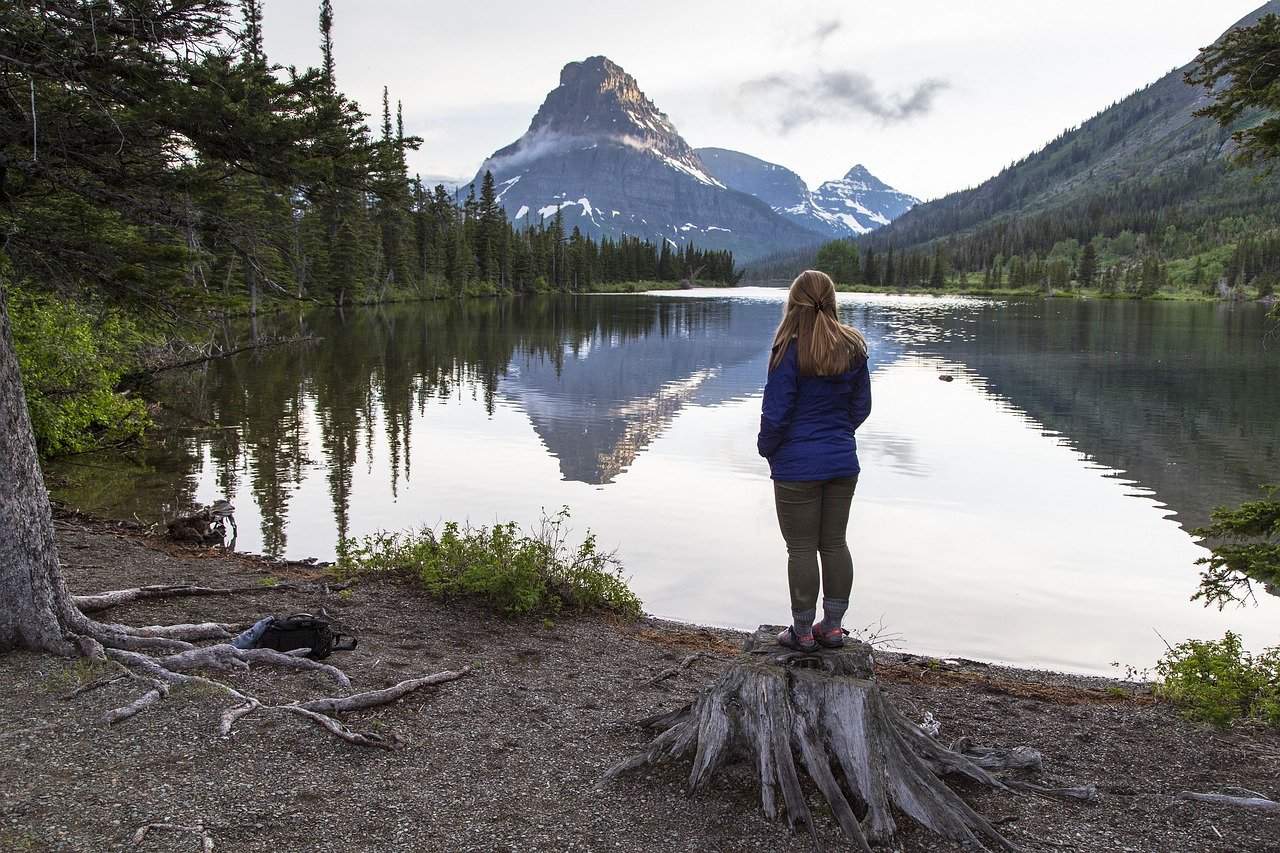Glacier National Park is a hikers paradise thanks to its 730 miles of trails, spectacular views, and once in a life-time hikes.
However, if your new to Glacier National Park which is located in the northwest corner of Montana, hikers can quickly get overwhelmed as the park encompassing more than 1 million acres and what seems like an endless amount of potential trails to choose from.
This is why we created this list of top 20 hiking tips for Glacier National Park in order to help those first-time hikers become familiar with the park and it’s trails so that they will be hiking like seasoned pros in no time.
Be Prepared to Be Self Relient
The first and most important thing to realize when hiking in Glacier Park is that you are usually hiking in remote and isolated areas. So it’s of the utmost importance that you come prepared for your hike whether it’s a short day hike or a longer multi-day hike.
Being prepared for your hike can mean many things to many different hikers but the main thing that you want to remember when hiking in the park is that you need to have the supplies and gear you need in order to be self-reliant.
As help can oftentimes be hours away if you run into trouble, especially if you are hiking in the backcountry.
Don’t Count on Your Cellphone
While you might occasionally find a cell phone signal when hiking in Glacier National Park depending on where you are and what carrier you have, you can almost count on not having cell phone service for most of the hike. As most of the national park has no cell phone service to speak of.
This means that while you are in the park and hiking along the trails you need to plan on your cell phone not working. Which for most of us can be a little jarring as first as it seems like we are always constantly looking at our cell phone throughout the day to provide information.
So when hiking in the Glacier National Park you need to make sure you have more low-tech equipment and tools such as a map of the area with clearly marked trails, a compass, and perhaps a digital watch so that you can stay informed on your location, surroundings, and timeline.
Bear Spray is a Must
Bear spray is an important piece of gear to have when hiking in the Glacier National Park.
While there are plenty of things you can do limit your chances of encountering a bear while hiking including making lots of noise by saying “Hey Bear!” ever so often or talking loudly with your hiking mates.
Bear spray is still one of those must-have pieces of hiking gear you should have close at hand for your peace of mind and just in case. (To check the price of one of the most popular bear spray cans on Amazon click here.)
It’s also important for you to know how to use your bear spray and to be comfortable and familiar with it. Don’t wait until you encounter a bear or are in a dangerous situation before attempting to use the bear spray for the first time.
If you are not familiar with bear spray or how to use it, check out this super helpful and entertaining video on YouTube about how to properly use bear spray.
Also, just to give you a heads up, if you are flying to Montana and the Glacier National Park, it’s best to buy your bear spray after you arrive as typically bear spray is not allowed on commercial flights.
Bears Are Not the Only Wildlife You Need to Be Cautious Of

While bears are what most people think of when they think of potentially dangerous wildlife at Glacier National Park. There are actually several different animals that can also potentially be dangerous while hiking at Glacier Park including moose, goats, and even mount lions.
While animal attacks are rare, it’s still important to be aware of potentially dangerous wildlife in the area while hiking and to follow all proper protocols to keep yourself as safe as possible while hiking.
For more information on proper protocols and how to stay safe while hiking at the park, you can visit the National Park Service safety page by clicking here that discusses bear, mountain lion, other wildlife, water, and steep terrain safety.
Always Hike in Groups
While it’s always a good idea not to hike alone and to hike in a group, it is especially important to hike in groups while at Glacier Park.
This is true for several reasons, to begin with when hiking in a group you are a more formidable presence to wildlife due to the increased size of your party as well as the noise a larger group will make leading to less of a chance to have a negative encounter with wildlife. As wildlife will typically steer clear of large groups of hikers making noise as they hike.
The second reason that it is always a good idea to hike in groups while at Glacier Park is due to the fact that there is always more safety in numbers especially when something goes wrong.
So going back to the point above about being self-reliant, hiking in a group is a great way to be self-reliant because if something were to go wrong or someone was to get hurt while hiking the other hikers can provide assistance or go get help.
Keep Your Hiking Group Together
This hiking tip for Glacier Park actually has to do with keeping your hiking group together and not letting hikers in your group get too far ahead or fall behind while on the trails.
Remember when hiking that you want to set the hiking pace based on the pace of the slowest hiker in your group.
This is important because when a hiker separates themselves from the group they are far more likely to get lost or have a negative encounter with wildlife while on the trails.
In fact, according to the National Park Service, more than 75% of the search and rescue operations at Glacier National Park have to do with separated parties.
Check on the Trail Status
Before heading out on your hike it’s always important to check the trail status so that you are aware of any closures or particular things you need to be aware of while hiking.
A great resource for this is to check The National Park Service trail status resource page for Glacier Park which you can check out by clicking here.
This page is packed with tons of useful information including trail status reports, closure areas, maintenance reports, and trail summaries.
So before heading out always make sure to check the status of the trail you plan to hike.
Don’t Over Estimate Your Hiking Abilities
There are trails for all skill levels and abilities at Glacier National Park.
So it’s important to have a good understanding of your fitness level and hiking abilities and then choose a hiking trail based on those abilities.
By doing this you are more likely to choose a trail that is a good match for your abilities and not get in over your head by hiking a trail that is beyond your capabilities as beginning hikers will sometimes do.
Some trail stats that you want to pay particular attention to when picking out your trail is the length of the trail, the elevation gain of the trail, and the trail rating which can range from easy to strenuous.
For those hikers that are unsure of their fitness level or hiking abilities, it’s best to start out with hiking trail that is shorter in distance, has little to no elevation change, and is rated as easy.
Know the Different Areas of the Park
There are five main areas to hike in the park with each area offering its own unique trails and experiences including Lake McDonald, Many Glacier, North Fork & Goat Haunt, St. Mary, and Two Medicine.
Lake McDonald Area
This is where most people enter the park and it can get very crowded at times. This particular area has the lowest base elevation of any area of the park at 3169 feet which is below the tree line. This means that most of the trails in this area are heavily shaded making them a great choice for those hot summer days.
A point worth mentioning about this area is that in 2017 and 2018 massive fires in the area burned approximately 30,000 acres, so it’s very possible that you might see or encounter these areas while on your hike.
For a detailed map of the Lake McDonald area with all its trails click here.
Many Glacier Area
The Many Glacier area which is located in the northeast corner of the park is many people’s favorite area of Glacier Park.
If you are looking for epic and expansive views of nature, mountains, and glaciers than you definitely need to check out this area. There is even a trail that dead-ends into a glacier giving you an up-close and personal view of one.
For a detailed map of the Many Glacier Area area with all its trails click here.
North Fork & Goat Haunt Area
The North Fork & Goat Haunt area is located on the park’s most northern edge and extends all the way to the Canadian border.
This area has many picturesque and remote finger lakes that can be a great place to get away from the crowds and to spend some relaxing time in nature. Be aware though that in order to access these remote lakes you will have to travel over some pretty rough gravel roads.
As a note, if you are trying to reach Goad Haunt which is a particular northern region of the park located near Waterton lake the only way you can reach this area is either by trail or through Canada.
For a detailed map of the North Fork area and its trails click here.
St. Mary Area
The St. Mary area includes trails that are on the east side of Sun Road and Logan Pass. In this area, you will find easy access to waterfalls, popular trails near Logan’s Pass, and hikes to high mountains passes with some spectacular views.
The St. Mary’s area has some of the best and most scenic trails at Glacier National Park and if you have the time you should definitely visit the area.
For a detailed map of the St. Mary’s area including all its trails click here.
Two Medicine Area
The final area of Glacier National Park is Two Medicine area which is located in the southeast area of the park.
There are over 3 million people that visit the park each year, so if you get tired of all the crowds the Two Medicine area is a great place to visit as it tends to be the least crowded.
But don’t think that this area is somehow lacking compared to the other areas of the park because of the lack of crowds, as this area actually has some of the most amazing trails for hiking and views in all the park.
For a detailed map of the Two Medicine area with all its trails click here.
Consider Filling Out a Day Trip Plan
For those that might be unfamiliar with a Day Trip Plan, it is simply a plan that details where and for how long you plan to hike that is left with a third party which can be used in case you don’t arrive back at your scheduled time to aid in search and rescue operations if needed.
The Glacier National Park has a specific form that you can use for your Day Trip Plan (which you can obtain a copy of by clicking here). While it’s not mandatory for you to fill out a Day Tip Plan before you hike in the park, it is a great fail-safe or back up plan just in case something were to go wrong.
If you do plan to use a Day Trip Plan the best place to leave the plan before you head out on your hike is either at the front desk of the hotel you are staying at or with someone in your group that is not going on the hike.
You Need a Permit to Camp in the Backcountry
If you are planning an overnight trip or camping in the backcountry at Glacier Park then you will need a backcountry permit in order to do so.
You can obtain a backcountry permit in several areas of the park including Apgar Backcountry Office, St. Mary Visitor Center, or ranger stations.
If you do plan on camping in the backcountry be forewarned that space is extremely limited in order to limit the impact on the natural surrounding and wildlife at the park.
So if you do plan on trying to obtain a permit to camp in the backcountry, the two things you need to do to help ensure the best chance for success is to plan ahead and be flexible with your plans.
Public Transportation is available in the Park

To help get around inside the park there is public transportation available which can come in handy because oftentimes parking lots can be full at trailheads.
Pubic transportation takes two main forms when inside the park including the hiking shuttle service as well as the bus service.
The hiking shuttles are small due to the size restrictions on Sun Road and seating can be limited, so be prepared for long wait times especially during the peak summer months if you plan to use them.
On the east side of the park, the hiker shuttle service is free along Sun Road from St. Mary to Logan Pass, and on the west side of the park, the shuttle service is free from Apgar to Logan Pass.
The other public transportation option in the park is the famous and iconic red busses but they only tend to be operating while the lodges are open.
While they are not free for a nominal fee of three to ten dollars on the west side they can take you to and from the train station or from Apgar to Lake Mcdonald, and on the east side, you can take a red bus from the Mini Glacier Hotel or the Motor Inn to the St. Mary visitor center.
Don’t Assume All Trails or Areas of the Park are Open Year Round
It’s important to know and remember that not all trails or areas of the park are open year-round due to winter weather as well as hazardous conditions. In fact, some areas of the park including certain lodges inside the park are open for only very limited windows of the year.
For example, the very popular Sun Road is only open in the summer opening in late June or early July depending on the weather and closing usually in mid-September to October.
In addition, the park’s lodges on the west side of the park don’t open until mid-May and close around late September or early October. While the lodges on the east side of the park don’t usually open until early June and tend to close in mid-September.
So if you are planning a trip to Glacier National Park it’s important to make sure that the trails and areas of the park are open when you plan to visit.
As a general rule of thumb though, if you plan to visit the park in the summer months you should be fine. But remember this is also the busiest time of the year for the park and when you will encounter the largest crowds.
Be Flexible with Your Plans
When planning your trip or hike at Glacier National Park it’s important to remember that while the area is certainly a tourist destination, it is not an amusement park. And the areas you are hiking in are real backcountry and wildlife areas.
Because of this when planning your trip or hike at the park it’s always a good idea to stay flexible with your plans as you may not be able to go on a particular hike on a particular day due to bad weather or wildlife issues.
So it’s a good idea to have a backup trail or plans in mind in case it’s not possible to go on the initial trail you had planned.
Some Trails are part of the Famous Continental Divide Trail

While we all have probably heard of the famous Appalachian Trail that goes up the east side of the US. Did you know there is another famous trail on the west side of the country that is even longer than the Appalachian trail called the Continental Divide Trail?
The Continental Divide Trail is a 3100-mile trail that starts in Mexico and goes all the way to Glacier National Park and then on to Canada.
And there are several trails at Glacier Park that are actually part of this famous trail that runs from Mexico to Canada.
There are Wheelchair Accessible Hikes
If someone in your group happens to be in a wheelchair there is no reason why they can’t join in on the fun of hiking while at Glacier National Park.
As there are two hikes that are wheelchair accessible at Glacier Park including The Trail of the Cedars and Eagle Falls Trail.
Stay on the Designated Trail
While it might be tempting at times to leave the designated trail to get a better vantage point or to check something out that you saw from the trail. Leaving the trail can oftentimes lead to trouble and makes it extremely difficult for search and rescue to find you in case you are unable to hike out on your own.
So while hiking at the Glacier National Park remember to stay on the trail to help you and your hiking party stay safe.
Bring Plenty of Water
While hiking at Glacier Park make sure to bring plenty of water to drink while on the trails especially during the summer.
If you’re not sure how much water is enough for the hike you are going to take, remember that it’s usually recommended you drink one liter of water for every two hours of active hiking in order to stay properly hydrated.
So if the hike you are planning to go on takes approximately four hours to complete, then you should bring two liters of drinking water with you on your hike.
Also, in regards to drinking water safety, never drink unfiltered water that you find along the trails from streams or lakes without first filtering the water.
Only Hike With What You Need
Oftentimes hikers will severely overpack for the hike they are planning to take.
While it’s important to be prepared and have some basic essentials even on shorter hikes while hiking at Glacier National Park including a map of the area, plenty of water and food, a flashlight, and perhaps a compass.
It’s also important to try and keep your pack as light as possible while hiking and not load it down with a bunch of unnecessary gear.
While everyone’s hiking gear might look a little different depending on their needs and what type of a hike they are going on, just make sure that before you stuff each item into your pack that you ask yourself if you really need this item on the trail.
By keeping your pack light you will not only be able to hike for longer without becoming tired or fatigued but also be able to enjoy the hike more as you will be less weighed down by gear.
Be Careful Around Snowfields and Glaciers
While snowfields and glaciers might be beautiful and one of the main attractions to the park they can also be dangerous if caution and care are not exercised around them.
The best practice in regards to snowfields and glaciers is to enjoy their beauty from afar to keep both you and your hiking party safe while hiking at Glacier Park. As snow bridges can conceal deep crevasses on glaciers or hidden cavities under snowfields, which can collapse under unsuspecting hikers leading to serious injury or worse.
So while snowfields and glaciers are beautiful it’s best to enjoy them from a distance.


